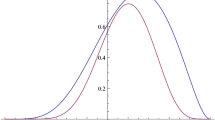Abstract
It is common in statistical practice that one needs to make a choice among m + 1 mutually exclusive claims on distributions. When m = 1, it is done by the (traditional) hypothesis test. In this paper, a generalization to the case m > 1 is proposed. The fundamental difference with the case m = 1 is that the new alternative hypothesis is a partition of m multiple claims and is data-dependent. Data is used to decide which claim in the partition is to be tested as the alternative. Thus, a random alternative is involved. The conditional and overall type I errors of the proposed test are controlled at a given level, and this test can be used as a new solution for the general multiple test problem. Several classical problems, including the one-sample problem, model selection in multiple linear regression, and multi-factor analysis, are revisited, and new tests are provided correspondingly. Consequently, the famous two-sided t-test should be replaced by the proposed.
Similar content being viewed by others
References
Anderson T W. An Introduction to Multivariate Statistical Analysis, 2nd ed. New York: Wiley, 1984
Benjamini Y, Hochberg Y. Controlling the false discovery rate: a practical and powerful approach to multiple testing. J R Stat Soc Ser B, 1995, 57: 289–300
Dunnett C W, Tamhane A C. A step-up multiple test procedure. J Amer Statist Assoc, 1992, 87: 162–170
Finner H, Strassburger K. The partitioning principle: a powerful tool in multiple decision theory. Ann Statist, 2002, 30: 1194–1213
Hald A. Statistical Theory with Engineering Applications. New York: Wiley, 1952
Hochberg Y. A sharper Bonferroni procedure for multiple tests of significance. Biometrika, 1988, 75: 800–803
Hogg R V, Fisher D M, Randles R H. A two-sample adaptive distribution-free test. J Amer Statist Assoc, 1975, 70: 656–661
Hogg R V, Lenth R V. A review of some adaptive statistical techniques. Comm Statist Theory Methods, 1984, 13: 1551–1579
Holm S. A simple sequentially rejective multiple test procedure. Scand J Statist, 1979, 6: 65–70
Kunter M H, Nachtsheim C J, Neter J, et al. Applied Linear Statistical Models, 5th ed. Irwin: McGraw-Hill, 2005
Lehmann E L, Romano J P. Generalizations of the familywise error rate. Ann Statist, 2005, 33: 1138–1154
Marcus R, Peritz E, Gabriel K R. On closed testing procedures with special reference to ordered analysis of variance. Biometrika, 1976, 63: 655–660
Montgomery D C, Peck E A, Vining G G. Introduction to Linear Regression Analysis, 3rd ed. New York: Wiley, 2001
O’Gorman T W. Applied Adaptive Statistical Methods. Tests of Significance and Confidence Intervals. ASA-SIAM Series on Statistics and Applied Probability, 12. Philadelphia, PA: Society for Industrial and Applied Mathematics (SIAM), Alexandria, VA: American Statistical Association, 2004
Author information
Authors and Affiliations
Corresponding author
Rights and permissions
About this article
Cite this article
Wang, W. On hypothesis testing with a partitioned random alternative. Sci. China Math. 53, 927–938 (2010). https://doi.org/10.1007/s11425-010-0071-1
Received:
Accepted:
Published:
Issue Date:
DOI: https://doi.org/10.1007/s11425-010-0071-1




